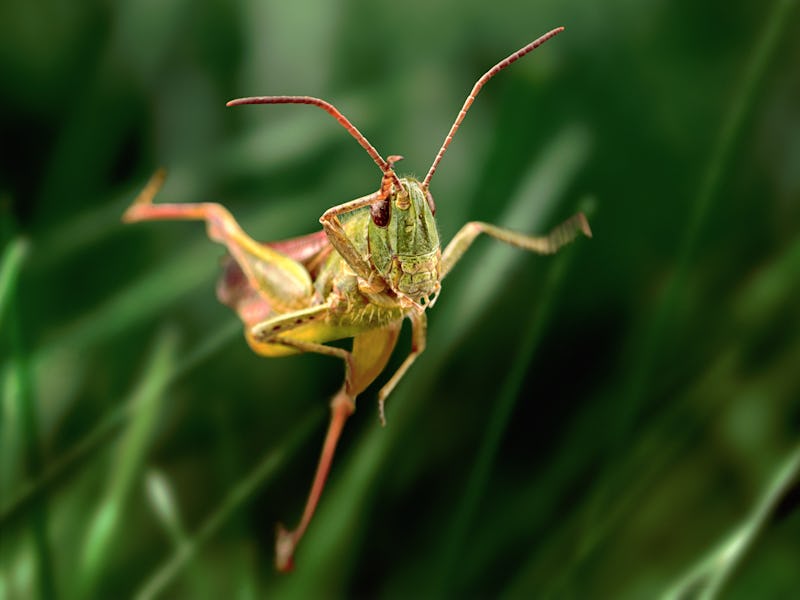Experimental locust design could change the future of flight
Locusts are gliding experts, and scientists want to build bio-inspired wings.

Scientists are always looking to invent newer and better things. But, sometimes mother nature has already beat them to it.
Evolution has created a lot of very good inventions, whether it’s using the silent wing of an owl to quiet wind turbines or, according to a study published Wednesday in the journal Royal Society Open Science, taking the gliding properties of a locust and using it to 3D print tiny drone wings.
The technology could be a boon for small vehicles and a springboard for bigger ones — including efficient drones and better airplane wings.
What’s new — The Desert locust (Schistocerca gregaria) is known for being a literal plague on agricultural areas. But this study takes a look at a specific facet of the locust: gliding. Through this they also are very good at swarming, avoiding collisions, and demonstrating exceptional flight control.
Prior studies had shown that much of this was due to their high-performance wings. The authors of the new study took a closer look and determined the most cost-effective ways to mass-produce wings. They weren’t looking to build a single, ideal wing, but instead wanted to determine the best way to build lots of them.
A graphical illustration of digitized wings sliced into sections and superimposed over an actual desert locust.
How it works — By creating a digital reconstruction of the locust wing and then enlarging it by three times (since actual locust wings are quite tiny), the team created various 3D printed wings before arriving at a 3D printed mold. They manufactured vacuum thermoformed wings in those molds and then used laser CNC machines to trim the wing membranes and insert patterns similar to those seen on locust wings.
Those patterns, which are made up of the insect-version of blood veins filled with haemolymph, turn out to be key to the locust’s flight abilities. But it’s hard to make those complicated wings in a single step, and mother nature had millions of years to figure this out. The team combined several different manufacturing methods (molding and casting, followed by two more curing processes) to create the final artificial wing design.
Stiffness and flexibility play a role too, and the presence of haemolymph means the insect might be able to use that liquid flow to alter the flexibility of its wings in unknown ways. To accommodate for the challenges to engineering this, the team instead found the best level of stiffness for their artificial wing. They made a number of different prototypes of varying weights and thicknesses to achieve different stiffness levels to determine the effect on flight.
By combining PVC wrap with the wings from the mold, an artificial locust wing is created.
Why it matters — Airplanes will often glide extended distances, both to save fuel and because that’s the most economical way to descend. When a pilot announces that a commercial flight is “beginning its descent” over the intercom, it typically means the engines have been throttled back to idle and the plane is going to glide for dozens of miles while it drops from cruising altitude down to the airport.
It’s also useful for emergencies, as we know from Chesley Sullenberger and the Miracle on the Hudson where the Airbus A320 glided just long enough to avoid the George Washington Bridge and to safely land on the river.
In testing, prototype wings had force applied to them and displayed significant abilities to bend without breaking. One prototype, shown above, reflected both high flexibility and the lightness and thinness needed to make flight more optimal.
The resulting wing design, the team says, allows for “affordable and accessible 3D printing, vacuum thermoforming, and laser CNC cutting” to mass-produce low-cost drone wings for tiny flapping robots. The findings could also help with aerodynamics research into better aircraft wings.
Abstract: In aviation, gliding is the most economical mode of flight explicitly appreciated by natural fliers. They achieve it by high-performance wing structures evolved over millions of years in nature. Among other prehistoric beings, locust is a perfect example of such natural glider capable of endured transatlantic flights that could inspire a practical solution to achieve similar capabilities on micro aerial vehicles. Although an investigation in this study demonstrates the effects of haemolymph on the flexibility of several flying insect wings proving that many species exist with further simplistic yet well-designed wing structures. However, biomimicry of such aerodynamic and structural properties is hindered by the limitations of modern as well as conventional fabrication technologies in terms of availability and precision, respectively. Therefore, here we adopt finite-element analysis to investigate the manufacturing-worthiness of a 3D digitally reconstructed locust wing, and propose novel combinations of economical and readily available manufacturing methods to develop the model into prototypes that are structurally similar to their counterparts in nature while maintaining the optimum gliding ratio previously obtained in the aerodynamic simulations. The former is assessed here via an experimental analysis of the flexural stiffness and maximum deformation rate as EIs = 1.34 × 10−4 Nm2, EIc = 5.67 × 10−6 Nm2 and greater than 148:2%, respectively. Ultimately, a comparative study of the mechanical properties reveals the feasibility of each prototype for gliding micro aerial vehicle applications.
If you liked this, you’ll love my weekly car review newsletter PRNDL. Click here to subscribe for free on Substack.